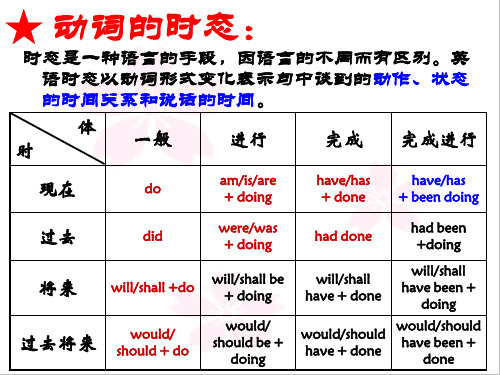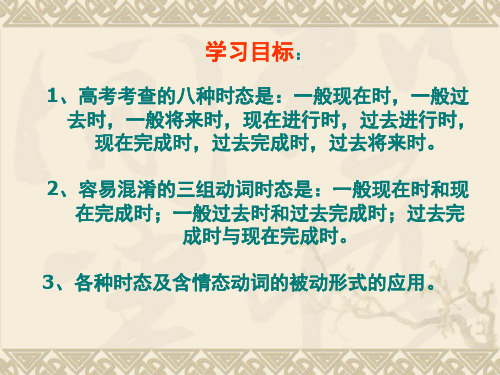动词的时态和语态.-xinjPPT课件
合集下载
《动词时态和语态》课件

语态的用法
被动语态的构成: be+过去分词
被动语态的用法: 表示主语是动作的 承受者
被动语态的时态: 根据主语的人称和 数以及时间状语来 选择
被动语态与系表结 构的区别:被动语 态强调动作,系表 结构强调状态
动词时态和语态的搭配使用
一般现在时与被动语态的搭配使用 现在进行时与主动语态的搭配使用 过去完成时与被动语态的搭配使用 过去进行时与主动语态的搭配使用
写作练习
动词时态和语态的 基本概念和用法
不同时态和语态的 辨析与选择
写作中常见的时态 和语态错误及纠正 方法
练习题及答案解析
总结与回顾
总结重点内容
动词时态的种类和用法 语态的分类和用法 时态与语态的辨析和区别 常见错误和注意事项
回顾学习过程
动词时态的分类与 定义
动词时态的用法与 辨析
语态的分类与定义
练习与巩固
选择题练习
● 题目:下列句子中,动词时态使用正确的是( ) A. He _______ (buy) a new car last year. B. They _______ (play) football in the park yesterday. C. We _______ (study) English since 2010. D. They _______ (not finish) their homework yet. ● A. He _______ (buy) a new car last year. ● B. They _______ (play) football in the park yesterday. ● C. We _______ (study) English since 2010. ● D. They _______ (not finish) their homework yet.
英语语法讲座第6讲动词的时态和语态精品PPT课件

动词的时态和语态
②在状语从句中,如if,unless,as long as,once,as soon as,when,before, till引导的状语从句中,此时主句谓语只能 用shall,will表示将来。
If he goes there tomorrow,I’ll go there,too.
表示从过去的 某时间看将要 发生的动作或 存在的状态
She said her father
would buy her a watch. 她说她父亲会给她买块 手表。
动词的时态和语态
时态
现在 完成时
用法
例句
表示动作在说话
之前已完成,但 对现在有影响
He has been to Japan. 他到过日本。
例句
How many new words had you learned by the end of last term? 到上学期末你学会了多 少新单词?
I have been working here for three years.我 一直在这里工作3年 了。
动词的时态和语态
2.将来时的六种表示方法 (1)用shall/will do表示单纯的将来。 在下列情况下只能用shall,will表示将 来: ①在含时间或条件等状语从句的主句中 只能用shall或will表示。 I’ll telephone you as soon as I get there. 我一到达那里就给你电话。
第六讲 动词的时态和语态
动词的时态和语态
一、动词的时态 1.考纲中规定有十种时态,现将其主 要用法归纳如下:
时态
一般 现在时
用法
表示经常 性、习惯性 的动作 表示现在的 状态、特征
高考英语复习——动词时态语态.ppt

(二)过去完成时 1 一件事情发生在过去,而另一件 事情先与他发生,发生在前的事 情的动词需用过去完成时。时间 状语用before
He said that he had been abroad for 3 years.
2表示从过去某一时间开始,一直延续 到过去的另一时间的动作
about it yet
He wrote many plays when he was at college.(写剧本是他过去做的事情) He has written many plays.(这意味着他是剧作 家) I saw Hero last year.(看英雄的时间是去年且 与现在无关) I have seen Hero before.(以前看过,强调现在 知道这部电影的内容。before:"以前"是表示一 个与现在有联系的时间,而不是一个确定的与 现在无关的过去时间)
It was ten years since we had had suan a wonderful time.
5 That/It/This was the first/second…time+that从句。that从 句的谓语要用过去完成时
That was the first time that I exam.
动词时态 和语态 一 时态
一 一般体中的一般现在时 一般过去时分别 表示现在 过去的经常性 习惯性动作或状态。 所谓一般体,表示既不 进行,又不完成
We day.
have
meals three times a
He is always ready to help others.
When I was a boy,I often went that park. to play in
动词的时态与语态共67张PPT

was/were going to do 或 would do
the next day等
专题9 动词的时态与语态3
时态 现在进行时 过去进行时
现在完成时
过去完成时
结构 am/is/are doing was/were doing
has/have done
had done
常连用的时间状语
now, these days等 at this time yesterday, at that time, when引导的时间 状语从句等 already, yet, ever, never, so far, for three days, since two days ago等 before, when引导的时 间状语从句, by+过 去时间
结构 am/is/are+过去分词
was/were+过去分词 will be或is/are going to be+过去分词 has/have been + 过去分词
情态动词+be+ 过去分词
示例
All these things are made by machines.
This book was written by Lu Xun.
专题9 动词的时态与语6态
4.在现在完成时的句子中,如果有持续的时间状语,要把非延续性动词变为 延续性动词。如: I have had the book for two days. 这本书我已经买了两天了。(用had,而不用bought) How long may I keep the book? 这本书我可以借多长时间?(用keep,而不用borrow)
The meeting took place in a beautiful city. 会议在一座美丽的城市举行。 A fire broke out during the night.
动词的时态和语态-PPT课件

8. The man _h_a_d__h_o_p_e_d__ (hope) to catch the last train, but he was too late.
9. The boys __w_e_r_e_p_l_a_y_in_g___ (play) basketball from 5:00 to 6:00 yesterday.Βιβλιοθήκη .19练习
.
20
用所给动词的正确形式填空: 1. She _l_e_ft__ (leave) the office two
hours ago. 2. As son as she arrived home, the girl
discovered that she _h_a_d__t_a_k_e_n__ (take) her friends book by mistake. 3. Who _c_o_m__e_s__ (come) to school earliest in your class every morning? 4. Great changes _h_a_v_e_t_a_k_e_n_p__la_c_e__ (take place) in this city since 1979. 5. By the time he was twelve, Edison _h_a_d__b_e_g_u_n_ (begin.) to sell newspape21rs.
I’ll go to see you when I have time. I’ll go to see you if I have time tomorrow. 2. 某些动词,如:stand, continue, wish, love, like, hate, feel, find, think等常用一般现在时态
9. The boys __w_e_r_e_p_l_a_y_in_g___ (play) basketball from 5:00 to 6:00 yesterday.Βιβλιοθήκη .19练习
.
20
用所给动词的正确形式填空: 1. She _l_e_ft__ (leave) the office two
hours ago. 2. As son as she arrived home, the girl
discovered that she _h_a_d__t_a_k_e_n__ (take) her friends book by mistake. 3. Who _c_o_m__e_s__ (come) to school earliest in your class every morning? 4. Great changes _h_a_v_e_t_a_k_e_n_p__la_c_e__ (take place) in this city since 1979. 5. By the time he was twelve, Edison _h_a_d__b_e_g_u_n_ (begin.) to sell newspape21rs.
I’ll go to see you when I have time. I’ll go to see you if I have time tomorrow. 2. 某些动词,如:stand, continue, wish, love, like, hate, feel, find, think等常用一般现在时态
高中英语语法 动词的时态、语态(共37张ppt)

❶表示在确定的过去时间里所发生的动作或存在的状态,常有表示过去时间的状语,或
有上下文暗示;还可表示 表示在过去一段时间内,经常性或习惯性的动作。
❷在时间、条件、让步状语从句中,若主句用了过去将来时,从句常用一般过去时表示
过去将来的意义。
❸有些动作发生的时间没有具体表明,但实际上是‘刚才,刚刚”发生,或者是表示说话人
1
问题诊断
2020/6/26
2
Ⅰ. 单句语法填空
1. Diets have changed in China—and so too has its top crop. Since 2011,the
country _h__a_s_g_r_o_w__n__ (grow) more corn than rice.(2018·全国卷Ⅱ)
were
2. It was Monday morning,and the writing class had just begin. (2018·全国卷Ⅲ)
begun
3.I had grown not only physically,but also mentally in the past few
I am going to buy some books with my sister this afternoon. 我打算下午和姐姐去买些书。 Look at the clouds. It is going to rain. 看那些乌云。天要下雨了。
2020/6/26
13
三、一般将来时
3 be to +动词原形, 表示按计划进行的动作或征求对方意见。还可 表示吩咐、命令、禁止、可能性等。
会20议20/6/2将6 于今天下午3点举行。
英语语法动词的时态、语态PPT课件

过去进行时
1.过去进行时主要表示在过去某一时刻或某一段时间内正 在进行或持续进行的动作。 He was reading while she was setting the table. 2.与always, continually, frequently等词连用,表示过去经 常发生的动作,具有浓厚的感情色彩。 The old man was always telling that old story. 3.表示过去打算实现,但未实现的动作 I was coming, but I missed the last bus.
过去完成时
过去完成时表示过去动作发生之前已经完成的动作。只有在 与过去时间相比较时,才能使用过去完成时。 1、过去完成时+before/when/by the time+一般过去时 When we got there, the plane had already left. The plane had already left before we got there. 2.一般过去时+after/until+过去完成时 They went simming after they had finished their homework. 3.hope, plan, mean, expect, suppose, think 等动词有时用 过去完成时表示本打算做而实际没有实现的事。 I had hoped to help you, but I couldn't get there in time.
现在完成时
现在完成时由“have+过去分词”构成。 1. 现在完成时所表示的动作在说话之前已经完成,而对现 在有影响,句中没有具体的时间状语。 He has gone to Fuzhou. He has been to Fuzhou. 2.现在完成时所表示的动作开始于过去,持续到现在,也 许还会继续持续下去。常用for+一段时间,since+时间点, in the past+时间段。 He has studied English for 5 years. He has studied English since 1990. He has studied English in the past 5 ye在的特征、状态、经常性动作或真理,客观事实等 。 He goes to school every day. His home is in shanghai, but he stays in beijing at the moment.
第三部分 第一讲 动词的时态和语态PPT课件

(4)be about to do表示客观上马上就要发生的事情,一般
语 法
不与具体的时间状语连用。
高 考
基
真
础 He is about to start on a journey.
题
初
体
探 他快要去旅行了。
验
(5)be doing指安排好要做的事情,并且很少变更。常用
突
破 于此结构的主要是一些短暂性动词,如go, come,
目录
第三部分ห้องสมุดไป่ตู้语法专题突破 第一讲 动词的时态和语态
译林版英语
第三部分 第一讲 动词的时态和语态
语 法 基 础 初 探
突 破 重 点 难 点
高 考 真 题 体 验
课 下 冲 关 演 练
译林版英语 目录
第三部分 第一讲 动词的时态和语态
语
高
法
考
基
真
础
题
初
翻译句子
体
探
验
1.我每天唱英文歌。
突
_I_s_in__g_E_n_g_l_i_sh__s_o_n_g_s_e_v_e_r_y_d_a_y_.
你今天下午打算参观科学博物馆吗?
关 演
It looks as if it is going to rain.
练
天看上去像是要下雨了。
译林版英语 目录
第三部分 第一讲 动词的时态和语态
语 (3)be to do表示按计划中约定的或按职责、义务和要求必须 高
法
考
基 去做的事情或即将发生的动作。
真
础
题
初
题 体
探
He said that he would wait for us at the station.
动词时态语态ppt课件

4) 用在一些句型里:
It is time you went to bed. I wish I were a bird. I'd rather you came tomorrow.
寒假来临,不少的高中毕业生和大学 在校生 都选择 去打工 。准备 过一个 充实而 有意义 的寒假 。但是 ,目前 社会上 寒假招 工的陷 阱很多
(客观安排) I’m going to play football tomorrow afternoon.
(主观安排)
■
现在进行时 寒假来临,不少的高中毕业生和大学在校生都选择去打工。准备过一个充实而有意义的寒假。但是,目前社会上寒假招工的陷阱很多
▲ 现在进行时的基本用法: a. 表示现阶段或目前正进行的动作。 We are waiting for you. Mr. Green is writing another novel this month.
doing
had done
had been +doing
will/shall have + done
will/shall have been +
doing
would/should have + done
would/should have been +
done
一般现在时的用法 寒假来临,不少的高中毕业生和大学在校生都选择去打工。准备过一个充实而有意义的寒假。但是,目前社会上寒假招工的陷阱很多 • 表示经常性或习惯性的动作或存在的状态,常
与表示频度的时间状语连用。 every…, sometimes, often, usually, on Sunday
I leave home for school at 7 every morning. He is alone.
It is time you went to bed. I wish I were a bird. I'd rather you came tomorrow.
寒假来临,不少的高中毕业生和大学 在校生 都选择 去打工 。准备 过一个 充实而 有意义 的寒假 。但是 ,目前 社会上 寒假招 工的陷 阱很多
(客观安排) I’m going to play football tomorrow afternoon.
(主观安排)
■
现在进行时 寒假来临,不少的高中毕业生和大学在校生都选择去打工。准备过一个充实而有意义的寒假。但是,目前社会上寒假招工的陷阱很多
▲ 现在进行时的基本用法: a. 表示现阶段或目前正进行的动作。 We are waiting for you. Mr. Green is writing another novel this month.
doing
had done
had been +doing
will/shall have + done
will/shall have been +
doing
would/should have + done
would/should have been +
done
一般现在时的用法 寒假来临,不少的高中毕业生和大学在校生都选择去打工。准备过一个充实而有意义的寒假。但是,目前社会上寒假招工的陷阱很多 • 表示经常性或习惯性的动作或存在的状态,常
与表示频度的时间状语连用。 every…, sometimes, often, usually, on Sunday
I leave home for school at 7 every morning. He is alone.
动词时态和语态总结.ppt

----Well , it _____ me.
A. isn’t B. wasn’t C. hasn’t been D. hadn’t been
2.----I’ve bought a box of chocolates for our daughter. ---Oh, how good a dad! But she doesn’t like sweet things. _____ that?
2. be going to do ①表示已经决定或安排好要做某事。 We are going to visit the Museum of Chinese History. ②根据某种迹象认为在最近或将要发生某事。 Tom studies very hard, and he is going to try for a scholarship.
学习目标:
1、高考考查的八种时态是:一般现在时,一般过 去时,一般将来时,现在进行时,过去进行时, 现在完成时,过去完成时,过去将来时。
2、容易混淆的三组动词时态是:一般现在时和现 在完成时;一般过去时和过去完成时;过去完 成时与现在完成时。
3、各种时态及含情态动词的被动形式的应用。
突破方法:
1、不可脱离语境学习时态和语态,而是要在了解了八种 常用时态的一些常用规则后,留心以英语为母语者在 实际生活中如何使用各种时态和语态。
常与last week/year/ month/ spring, a few days ago, in 1998等时间状语以及when等连词引
导的时间状语从句连用。
We had a good swim last Sunday. When I was young, I took cold baths regularly.
A. isn’t B. wasn’t C. hasn’t been D. hadn’t been
2.----I’ve bought a box of chocolates for our daughter. ---Oh, how good a dad! But she doesn’t like sweet things. _____ that?
2. be going to do ①表示已经决定或安排好要做某事。 We are going to visit the Museum of Chinese History. ②根据某种迹象认为在最近或将要发生某事。 Tom studies very hard, and he is going to try for a scholarship.
学习目标:
1、高考考查的八种时态是:一般现在时,一般过 去时,一般将来时,现在进行时,过去进行时, 现在完成时,过去完成时,过去将来时。
2、容易混淆的三组动词时态是:一般现在时和现 在完成时;一般过去时和过去完成时;过去完 成时与现在完成时。
3、各种时态及含情态动词的被动形式的应用。
突破方法:
1、不可脱离语境学习时态和语态,而是要在了解了八种 常用时态的一些常用规则后,留心以英语为母语者在 实际生活中如何使用各种时态和语态。
常与last week/year/ month/ spring, a few days ago, in 1998等时间状语以及when等连词引
导的时间状语从句连用。
We had a good swim last Sunday. When I was young, I took cold baths regularly.
- 1、下载文档前请自行甄别文档内容的完整性,平台不提供额外的编辑、内容补充、找答案等附加服务。
- 2、"仅部分预览"的文档,不可在线预览部分如存在完整性等问题,可反馈申请退款(可完整预览的文档不适用该条件!)。
- 3、如文档侵犯您的权益,请联系客服反馈,我们会尽快为您处理(人工客服工作时间:9:00-18:30)。
He is always helping others.他总是肯帮助他人。
She is always forgetting something. 她老是忘记某些事情。 ④大多数动词可用于进行时,但也有些动词不用于进行 时。
2021
常见的有: ▲感觉类:look, smell, feel, sound, taste,
to等。
2021
3.现在完成时 ①表示过去发生的动作对现在产生的影响或结果,或
说话时已完成的动作;
I have finished the report./ She has cleaned the room. ②表示从过去开始,持续到现在的动作或状态,往往和
“for...”, “since...”表述的一段时间状语连用;
He has learned English for six years.
They have worked here since they left college. ③表示“曾经到过某地(人已回来)”用“have/has been
to”; 表示“到某地去了(还未回来)”用“have/has gone to”。
—Where is Li Hua? -He has gone to the reading-room.
—She knows a lot about Shanghai. -She has been ther ④在时间状语从句,条件状语从句或让步状语从句中表达 将来某时已经完成的动作。
2021
When you have learned English, you will find it a bridge to so much knowledge. We’ll start at six if it has stopped raining by then.
A.will wait
B. wa
D. are waiting
答案:D
考点:本题是在语境中考查学生对时态的灵活运用。
解析:第一个说话人说“我还没吃完饭呢”,而
下
的人则说“但是我们的朋友们都在等我们了”根
据第
一个人还没进行完吃饭的动作,而第二个人又开
始 催促,我们得知朋友们此20时21 正在等他们。所以用
but I’ve never regretted my final decision to
move back to China.
A. lived
B. was living
C. have lived
D. had lived
答案 A
解析 考查动词的时态。根据后一句判断,
我已回中国了,因此在伦敦住了多年是
B. is called
C. had been called
D. has been called
虽然航海发生在过去,但是,海洋的名称不会因
此而变化,所以要用一般现在时。
2021
2.现在进行时 ①表示正在进行的动作; ②表示按计划安排即将发生的动作。 She is leaving for Beijing.她要去北京。
2021
注意:近几年,对一般现在时的考查常用过 去时态或现在完成时态对考生进行干扰。
Months ago we sailed ten thousand miles across
the open sea, which_____ the Pacific, and we
met no storm.
A. was called
过去的事了,故用过去时态。
2021
二是题干中不提供任何时间状语, 而给出一个上下文情境或一个结 构较为复杂的句子,考生必须仔 细分析语境,才能作出判断并选 择最佳答案。
2021
--I'm not finished with my dinner yet.
--But our friends for us. (10北京24)
注意:这里的现在完成时强调从句动作在主句动作之 前完成, 如果两个动作同时或几乎同时发生, 则不必用完 成时;试比较:
I’ll let you know as soon as I hear from her. She will call you when she gets home. ⑤短暂动词(即瞬间动词), join,lose,buy,borrow,leave,go,come,arrive,die,marry, finish,complete,begin,start,break out等,在完成时态中, 其肯定式不能和表示一段时间的状语连用。 要译“他参军已经三年了”不能说:He has joined the army for three years.可采用:
动词的时态和语态
英语组校本研修
2021
英语中动词的时态和语态既是重 点,又是难点,也是高考的命题 热点。我们不难发现失分率最高 的常常是两类试题:
2021
一是题干给定时间状语,但所给 时间状语有着较强的干扰性和迷 惑性,考生不能直接根据时间状 语进行选择;
2021
(06重庆31)
I
in London for many years,
动词时态的用法 1.一般现在时
①一般现在时表示经常发生、习惯性动作、 客观真理、科学事实、格言,目前的特征、状态、 能力等;
②主句是一般将来时,时间、条件状语从句中 用一般现在时表示将来;
I’ll go there after I finish my work.
If it rains tomorrow, I won’t go there. ③在以here, there开头的句子里,go, come 等少数动词的一般现在时表示正在发生的动作; There goes the bell.铃响了。There comes the bus.汽车来了。Here she comes.她来了。
He is working as a teacher tomorrow. 从明天起他要做老师。
My father is coming to see me this Saturday. 这个星期六我爸爸要来看我。 ③与always, forever, constantly, continually连用,表 示赞赏或厌恶等感情色彩,但并非强调动作正在进行;
see, hear ▲情感类:like, love, prefer, admire, hate,
fear ▲心态类:wish, hope, expect, want, need,
believe, think, understand, agree, know ▲所有类:have, contain, won, hold, belong
She is always forgetting something. 她老是忘记某些事情。 ④大多数动词可用于进行时,但也有些动词不用于进行 时。
2021
常见的有: ▲感觉类:look, smell, feel, sound, taste,
to等。
2021
3.现在完成时 ①表示过去发生的动作对现在产生的影响或结果,或
说话时已完成的动作;
I have finished the report./ She has cleaned the room. ②表示从过去开始,持续到现在的动作或状态,往往和
“for...”, “since...”表述的一段时间状语连用;
He has learned English for six years.
They have worked here since they left college. ③表示“曾经到过某地(人已回来)”用“have/has been
to”; 表示“到某地去了(还未回来)”用“have/has gone to”。
—Where is Li Hua? -He has gone to the reading-room.
—She knows a lot about Shanghai. -She has been ther ④在时间状语从句,条件状语从句或让步状语从句中表达 将来某时已经完成的动作。
2021
When you have learned English, you will find it a bridge to so much knowledge. We’ll start at six if it has stopped raining by then.
A.will wait
B. wa
D. are waiting
答案:D
考点:本题是在语境中考查学生对时态的灵活运用。
解析:第一个说话人说“我还没吃完饭呢”,而
下
的人则说“但是我们的朋友们都在等我们了”根
据第
一个人还没进行完吃饭的动作,而第二个人又开
始 催促,我们得知朋友们此20时21 正在等他们。所以用
but I’ve never regretted my final decision to
move back to China.
A. lived
B. was living
C. have lived
D. had lived
答案 A
解析 考查动词的时态。根据后一句判断,
我已回中国了,因此在伦敦住了多年是
B. is called
C. had been called
D. has been called
虽然航海发生在过去,但是,海洋的名称不会因
此而变化,所以要用一般现在时。
2021
2.现在进行时 ①表示正在进行的动作; ②表示按计划安排即将发生的动作。 She is leaving for Beijing.她要去北京。
2021
注意:近几年,对一般现在时的考查常用过 去时态或现在完成时态对考生进行干扰。
Months ago we sailed ten thousand miles across
the open sea, which_____ the Pacific, and we
met no storm.
A. was called
过去的事了,故用过去时态。
2021
二是题干中不提供任何时间状语, 而给出一个上下文情境或一个结 构较为复杂的句子,考生必须仔 细分析语境,才能作出判断并选 择最佳答案。
2021
--I'm not finished with my dinner yet.
--But our friends for us. (10北京24)
注意:这里的现在完成时强调从句动作在主句动作之 前完成, 如果两个动作同时或几乎同时发生, 则不必用完 成时;试比较:
I’ll let you know as soon as I hear from her. She will call you when she gets home. ⑤短暂动词(即瞬间动词), join,lose,buy,borrow,leave,go,come,arrive,die,marry, finish,complete,begin,start,break out等,在完成时态中, 其肯定式不能和表示一段时间的状语连用。 要译“他参军已经三年了”不能说:He has joined the army for three years.可采用:
动词的时态和语态
英语组校本研修
2021
英语中动词的时态和语态既是重 点,又是难点,也是高考的命题 热点。我们不难发现失分率最高 的常常是两类试题:
2021
一是题干给定时间状语,但所给 时间状语有着较强的干扰性和迷 惑性,考生不能直接根据时间状 语进行选择;
2021
(06重庆31)
I
in London for many years,
动词时态的用法 1.一般现在时
①一般现在时表示经常发生、习惯性动作、 客观真理、科学事实、格言,目前的特征、状态、 能力等;
②主句是一般将来时,时间、条件状语从句中 用一般现在时表示将来;
I’ll go there after I finish my work.
If it rains tomorrow, I won’t go there. ③在以here, there开头的句子里,go, come 等少数动词的一般现在时表示正在发生的动作; There goes the bell.铃响了。There comes the bus.汽车来了。Here she comes.她来了。
He is working as a teacher tomorrow. 从明天起他要做老师。
My father is coming to see me this Saturday. 这个星期六我爸爸要来看我。 ③与always, forever, constantly, continually连用,表 示赞赏或厌恶等感情色彩,但并非强调动作正在进行;
see, hear ▲情感类:like, love, prefer, admire, hate,
fear ▲心态类:wish, hope, expect, want, need,
believe, think, understand, agree, know ▲所有类:have, contain, won, hold, belong
